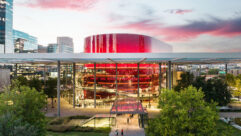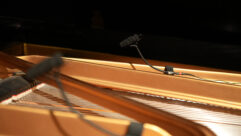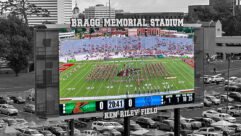
Clemson University Upgrades Performing-arts Center
Jun 18, 2008 12:00 PM,
By Linda Seid Frembes

When most people think of Clemson University in Clemson, S.C., one word comes to mind: “football.” But believe it or not, the school also has a thriving performing-arts department that oversees the campus’s largest non-athletic venue, the 1,000-seat Brooks Center for the Performing Arts. “Because of our size, we constantly host internal events like nurse pinnings, special lectures, and award ceremonies,” says Woody Moore, production supervisor for the venue. “We also have a show season of about 40-50 external events ranging from spoken word performances to chamber music, dance, theater, and Broadway tours.”
With a total of more than 100 shows during the nine-month school year, Moore and his technical staff of more than 60 students have to be versatile and ready to lend their technical support for any situation. Those same criteria extended to their aging sound system, which was used for most shows except Broadway tours that carried their own production. “The original Meyer Sound system was installed when the building was built 15 years ago,” Moore says. “Previously it was a center cluster of Altec Lansing exposed horns and JBL low-end cabinets. Somewhere along the way, someone added a Meyer UPA on the left and right and two USW-1P subwoofers.”
The system was underpowered, so Moore had to constantly rent out gear to provide enough sound coverage for the venue. “We spent lots of time and money on rental systems,” he says.
When it came time for an upgrade, factors such as proper sound coverage, reliability, and versatility were top of the list. Because of the center’s positive experience with Meyer Sound, it was no question in Moore’s mind that the new system would carry the same brand. Moore worked with Real World Audio in Asheville, N.C., to install a new left-center-right system of two hangs of 10 Meyer Sound M’elodie line-array loudspeakers, with a center cluster of four Meyer Sound CQ-1 loudspeakers. Three UPJ-1P VariO loudspeakers were added as balcony delays, and four M1D line array loudspeakers were installed along the stage lip for front fills. Four 700-HP subwoofers on the floor provide low-frequency coverage. On stage, eight UM-1P stage monitors provide foldback.
“The new system can do anything we want and we don’t need to rent any extra gear. The system can cross 120dB with ease; there is plenty of headroom,” says Moore, who tested the system out one evening using his ears and a stack of his favorite CDs.
1
Clemson University Upgrades Performing-arts Center
Jun 18, 2008 12:00 PM,
By Linda Seid Frembes

The left and right hangs of M’elodie line arrays were new for the Brooks Center, which never had a line array installed there before. The line arrays presented both challenges and opportunities for the venue. “The architects had included a place in the ceiling for a center cluster in the building design, but we weren’t sure if we needed to rip apart the ceiling to accommodate the new line arrays,” Moore says. “But we found we could remove the acoustical treatment and the underlying plywood and mount them with the rigging up in the ceiling. The result is that the rigging is hidden and the line arrays look like they belong in the room. That coincidence saved money on destruction and construction of the space.”
As for why they chose a line array in the first place, Moore notes that the Brooks Center is a performing-arts venue as well as an educational facility. “The line array works as an educational tool,” says Moore, who teaches a sound-reinforcement class at Clemson. “Using the Galileo loudspeaker management system, I can mute individual boxes to show the students what comb filtering sounds like or I can demonstrate EQ and how it affects phase, and have a graphic display for a real-world scenario. It’s one thing to teach these things as theory, but when I do it in the room, they really grasp what it sounds like.”
In addition to the new sound system, the Brooks Center also replaced their console with a new Digico D1 digital console and added a transformer and ground isolation, as well as a Lyntech sequential power rack with one-touch on/off. In the future, Moore’s plans for the Center include a 70V paging system for the dressing rooms and backstage area and perhaps a new acoustic shell.
2










